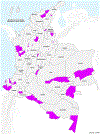Progress towards the elimination of hepatitis B in children in Colombia: A novel two-phase study approach
- PMID: 35707957
- PMCID: PMC10200037
- DOI: 10.1111/jvh.13719
Progress towards the elimination of hepatitis B in children in Colombia: A novel two-phase study approach
Abstract
The World Health Organization (WHO) has established a target to eliminate mother-to-child-transmission (EMTCT) of hepatitis B virus (HBV), defined as a prevalence of hepatitis B surface antigen (HBsAg) of ≤0.1% among children, by 2030. Using nationally representative serosurveys to verify achievement of this target requires large sample sizes and significant resources. We assessed the feasibility of a potentially more efficient two-phase method to verify EMTCT of HBV in Colombia. In the first phase, we conducted a risk assessment to identify municipalities at the highest risk of ongoing HBV transmission. We ranked the 1122 municipalities of Colombia based on the reports of HBV infection in pregnant women per 1000 population. Municipalities with ≥0.3 reports per 1000 persons (equating to the top quartile) were further assessed based on health facility birth rates, coverage with three doses of hepatitis B vaccine (HepB3) and seroprevalence data. Hepatitis B risk was considered to be further increased for municipalities with HepB3 coverage or health facility birth rate <90%. In the second phase, we conducted a multistage household serosurvey of children aged 5-10 years in 36 municipalities with the highest assessed HBV risk. HBsAg was not detected in any of 3203 children tested, yielding a 90% upper confidence bound of <0.1% prevalence. Coverage with HepB3 and hepatitis B birth dose was high at 97.5% and 95.6%, respectively. These results support the conclusion that Colombia has likely achieved EMTCT of HBV.
Keywords: Colombia; hepatitis B; hepatitis B vaccines; immunization; seroprevalence.
© 2022 John Wiley & Sons Ltd. This article has been contributed to by U.S. Government employees and their work is in the public domain in the USA.
Conflict of interest statement
CONFLICT OF INTEREST
The authors have no conflicts of interest to declare.
Figures
References
-
- World Health Organization (WHO). Global Progress Report on HIV, Viral Hepatitis and Sexually Transmitted Infections, 2021. World Health Organization; 2021. Accessed June 22, 2022. https://www.who.int/publications/i/item/9789240027077
-
- World Health Organization(WHO). Hepatitis B vaccines: WHO position paper - July 2017. WER. 2017;27(92):369–392. Accessed June 22, 2022. https://apps.who.int/iris/bitstream/handle/10665/255841/WER9227pdf?seque...
-
- World Health Organization (WHO). Global Health Sector Strategy on Viral Hepatitis 2016–2021: World Health Organization; 2016. Accessed June 22, 2022. https://apps.who.int/iris/bitstream/handle/10665/246177/WHO-HIV-2016.06-...
-
- Pan American Health Organization. EMTCT Plus. Framework for Elimination of Mother-Tochild Transmission of HIV, Syphilis, Hepatitis B, and Chagas PAHO; 2017. Accessed June 22, 2022. https://iris.paho.org/bitstream/handle/10665.2/34306/PAHOCHA17009-eng.pd...
-
- World Health Organization (WHO). Documenting the Impact of Hepatitis B Immunization: Best Practices for Conducting a Serosurvey. World Health Organization; 2011. Accessed June 22, 2022. http://whqlibdoc.who.int/hq/2011/WHO_IVB_11.08_eng.pdf
Publication types
MeSH terms
Substances
Grants and funding
LinkOut - more resources
Full Text Sources
Medical


